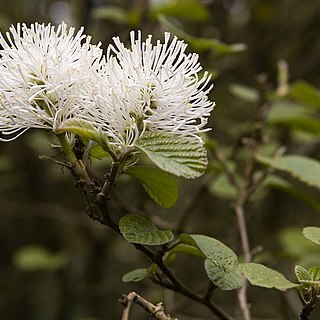Evergreen or deciduous trees or shrubs, often with stellate indumentum. Leaves alternate or less often opposite, simple, but often pinnatifid or palmatilobed, entire or serrate (the teeth sometimes glandular), usually stipulate; stipules mostly paired, persistent or more usually deciduous. Inflorescences terminal or axillary, racemose, often spicate or capitate, sometimes so densely packed that the flowers are almost joined; bracts and bracteoles often present, the former sometimes forming a coloured involucre. Flowers small to large, regular or rarely irregular, hermaphrodite or unisexual, hypogynous to perigynous, rarely without a perianth. Calyx-tube variously shaped, usually ± adnate to the ovary; lobes (3–)5(–7), imbricate or valvate. Petals 4–5 or more, sometimes absent in ? flowers, free, imbricate or valvate, rarely circinate, mostly linear-spathulate or obovate. Stamens 4–5(–25), rarely fewer, as many as and alternating with the petals, arranged in one series; staminodes sometimes present; filaments free, sometimes thickened and shorter than the anthers; anthers 2-thecous, opening lengthwise or by valves, the connective sometimes projecting to form a beak. Disc usually absent, when present annular or composed of separate glands. Ovary inferior, half-inferior or rarely superior, (l–)2(–3)-locular, the carpels sometimes free at the apex; ovules 1 or more in each cell, apical or anatropous, pendulous; placentation axile; styles 2, subulate, usually free, often recurved, sometimes persistent, the stigmas terminal or lateral. Fruit a woody loculicidal or septicidal capsule, with leathery exocarp and bony endocarp, often appearing apically 4-valved. Seeds 1–many, sometimes winged, with thin endosperm; embryo straight
Trees or shrubs , deciduous; pubescence stellate or sometimes simple. Dormant buds naked or scaly. Leaves alternate, simple, petiolate; stipules early deciduous. Leaf blade unlobed or deeply (3-)5-7-lobed, pinnately or palmately veined. Inflorescences axillary or terminal, capitate or spicate to ± racemose, bracteate. Flowers bisexual or unisexual; perianth epigynous, 1-2-seriate, 4-5-merous, often reduced or absent, hypanthium present; calyx persistent, 4-5(-7)-lobed, or absent; petals distinct or absent; stamens 4-34; anthers basifixed, latrorse, 2-locular, longitudinally dehiscent by simple slit or by 1-2 vertical valves; pistil 1, 2-carpellate; ovary half-inferior, 2-locular; placentation axile; ovules 1(-2) in each locule and apical, or many, anatropous, pendent; styles and stigmas persistent, 2 each, erect or contorted and recurved. Fruits capsular, with leathery exocarp and bony endocarp, loculicidal and 2-seeded or septicidal with most of many seeds per locule aborted; 1-2 viable seeds per locule ( Liquidambar ). Seeds fusiform, bony, lustrous, hilum apical, light colored, or seeds winged, hilum lateral ( Liquidambar ).
Shrubs or trees, monoecious, rarely dioecious. Leaves simple, alternate, rarely opposite, simple to palmately lobed, petiolate; stipules usually present. Inflorescence usually a spike, sometimes a raceme or panicle, bracteate. Flowers bisexual or unisexual, usually regular. Sepals 4 or 5, free or connate, small, sometimes absent. Petals 4 or 5, ligulate, small, sometimes absent. Stamens 4 or 5, free, often in 2 whorls with inner whorl staminodal; anthers usually basifixed, the connective often produced into an appendage, each locule (in Australia) with 2 pollen sacs and 1 valve. Ovary usually inferior, sometimes superior, with 2, rarely 3, carpels; styles 2, rarely 3, free, usually persistent in fruit; ovules 1 or 2, pendulous, or 5-many, anatropous. Fruit (in Australia) a loculicidal capsule, woody. Seeds sometimes winged; endosperm present.
Stamens 1-seriate, usually as many as and alternating with the petals, rarely fewer or indefinite, perigynous; filaments free; anthers 2-locular, opening lengthwise by slits or by valves; the connective often produced; staminodes sometimes present, alternating with the stamens
Ovary inferior or nearly so, rarely sub-superior, (l)2(3)-carpellary and-locular; carpels often free at the apex; styles subulate, free, often recurved and persistent; stigmas terminal or lateral; ovules 1-many in each loculus, axillary, pendulous
Leaves alternate or less often opposite, deciduous or persistent, simple, entire or not, pinnately or palmately nerved; stipules mostly paired, often deciduous
Inflorescences racemose, often spicate or capitate, sometimes very dense, terminal or axillary; bracts and bracteoles often present
Petals 4–5 or more, sometimes absent in female flowers, free, imbricate or valvate, rarely circinnate
Calyx-tube ± adnate to the base of the gynoecium; calyx-lobes 4–5 or more, imbricate or valvate
Flowers bisexual or unisexual, actinomorphic or rarely zygomorphic, rarely without a perianth
Seeds mostly 1 per loculus, sometimes winged; endosperm thin; embryo straight
Fruit a woody capsule, loculicidal or septicidal
Trees and shrubs, often with stellate indumentum
Disk absent or annular or of separate glands

